April 4th Scots Book of Days
April 4 – 1305 King Philip IV of France reign ends.
1366 Henry IV of England born. Henry Bolingbroke, Earl of Derby (by courtesy until his father’s death)
Earl of Northampton – restored 1384 to his father-in-law’s Earldom
Duke of Hereford – after the punishment of the Lords Appellant
AD 1387 2nd Duke of Lancaster – upon his father’s death,
AD 1399. King of England, Henry IV by deposition of his cousin Richard II,
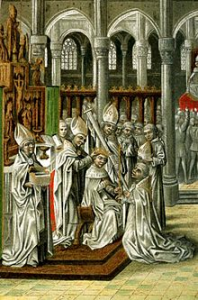 AD 1399 The Coronation of Henry IV of England. From 15th century manuscript of Jean Froissart’s Chronicles.
AD 1399 The Coronation of Henry IV of England. From 15th century manuscript of Jean Froissart’s Chronicles.
1373 Parliament held by King Robert II at Scone, resolved that his son, the Earl of Carrick should succeed his father as King (as Robert III although he was baptized John).
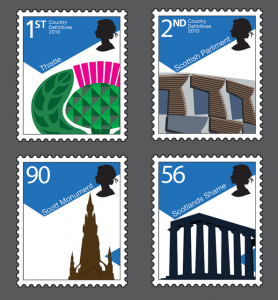 Thistle, Parliament, Monument, Scotland’s Shame.
Thistle, Parliament, Monument, Scotland’s Shame.
“Scotland’s Disgrace” or “Scotland’s Pride and Poverty” or “Edinburgh’s Shame” the National Monument on Calton Hill in Edinburgh was supposed to have been a memorial to the Scots who died in the Napoleonic Wars. The idea was to create a copy of the Parthenon in Athens (Edinburgh is sometimes called the “Athens of the North”).
Sir Walter Scott, Sir Henry Cockburn and others launched a subscription to pay the estimated cost of 42,000 pounds.
The foundation stone was laid on 27 October 1822 but three years later work stopped as less than half the cost had been subscribed.
The twelve Doric columns on their base still remain, and it made a stamp.
1384 John of Gaunt, son of Edward III attacks Scotland.
 John of Gaunt, 1st Duke of Lancaster (second creation), Knight of Garter (6 March 1340 – 3 February 1399) was a member of the House of Plantagenet, the third surviving son of King Edward III of England and Philippa of Hainault. John is 2nd great grandfather of Henry VII Tudor and Joan Beaufort, Queen of Scots, from whom are descended, beginning in 1437, all subsequent sovereigns of Scotland, and successively, from 1603 on, the sovereigns of England, of Great Britain and Ireland, and of the United Kingdom to the present day. The three succeeding houses of English sovereigns from 1399 — the Houses of Lancaster, York and Tudor — were descended from John through Henry Bolingbroke, Joan Beaufort and John Beaufort, respectively. Wikipedia
John of Gaunt, 1st Duke of Lancaster (second creation), Knight of Garter (6 March 1340 – 3 February 1399) was a member of the House of Plantagenet, the third surviving son of King Edward III of England and Philippa of Hainault. John is 2nd great grandfather of Henry VII Tudor and Joan Beaufort, Queen of Scots, from whom are descended, beginning in 1437, all subsequent sovereigns of Scotland, and successively, from 1603 on, the sovereigns of England, of Great Britain and Ireland, and of the United Kingdom to the present day. The three succeeding houses of English sovereigns from 1399 — the Houses of Lancaster, York and Tudor — were descended from John through Henry Bolingbroke, Joan Beaufort and John Beaufort, respectively. Wikipedia
1406 Robert III (born John Stewart) the Lame King (Roibert III Stiùbhairt, An Righ Bhacaigh) 1390–1406, King Scots died. Robert’s son James (later designated the First) begins reign, sort of. (TG17-252) (but was not crowned until 1424 as he was a prisoner of the English). Robert’s brother, the Duke of Albany assumed the regency of the kingdom
 Robert III (born John Stewart) the Lame King & Anabella Drummond 1367.
Robert III (born John Stewart) the Lame King & Anabella Drummond 1367.
- Drummond of Cargill Stubhall Perth 8th c 2Hamilton2Stewart 2miller2Simmons 2Choate Zoë
1508 The Great Prologue. Andro Myllar. Production of the first printed book in Scotland with a definite date – a vernacular poem by John Lydgate ‘The Complaint of the Black Knight’. The press, imported from the Continent, was set up in Edinburgh by Walter Chepman, an Edinburgh merchant, and his business partner Androw Myllar, a bookseller, near what is now Cowgate. YYMA 37 in 1508, the two had a printing house in Southgait (now Cowgate), Edinburgh, at the foot of Blackfriars’ Wynd. The printers had to be trained to use the press before they left Europe. The book for whose production the King had licensed the importation, the Aberdeen Breviary which Bishop William Elphinstone prepared on the Serum model, was brought out in 1509-10, but Chepman’s name alone appears as its publisher. The only known Scottish book with which Androw Myllar’s name is associated—and the first known book to be printed in Scotland—was published by the two under date of 4 April 1508. The unique surviving copy was given to the Advocates’ Library, the Library of the Faculty of Advocates at Edinburgh, now the National Library of Scotland in Edinburgh, by one John Alston of Glasgow in 1788. Titled The Maying or Disport of Chaucer, this fourteen leaf publication bears Chepman’s device on the first page, Myllar’s on the last. (Actually, the attribution is mistaken; the text, also known as The Complaint of the Black Knight, is by Lydgate, not Chaucer.) YYMA. In 2010 The Complaint was chosen by UNESCO to become part of its Memory of the World Register. Wikipedia.
 A sculpted tablet on the facade of Edinburgh’s Central Library commemorates Myllar. The spread of the movable type printing press was Mainz Germany 1452, Cologne 1466, Rome 1467, Venice Republic 1469, Paris France and Milan Italy 1470, Florence Genoa and Bologna Italy 1471, Cracow 1473, London England 1477, Seville Spain 1472, Utrecht 1473, Geneva 1478, Rouen 1480 [Myllar’s type font was imported from Rouen], Antwerp 1480, Vienna Austria 1482, Prague 1487, Edinburgh Scotland 1508, Mexico City New Spain 1544, St Andrews Scotland 1552, Moscow Russia 1553, Goa Asia 1556, Stirling Scotland 1571, Aberdeen Scotland 1622, Glasgow Scotland 1638, Leith Scotland 1651, Campbelltown 1685, Maybole 1694, Philadelphia Pennsylvania 1686, New York 1693, Tahiti 1818, Hawaii 1821, San Francisco California 1846, Salt Lake City Deseret 1850, Wikipedia.
A sculpted tablet on the facade of Edinburgh’s Central Library commemorates Myllar. The spread of the movable type printing press was Mainz Germany 1452, Cologne 1466, Rome 1467, Venice Republic 1469, Paris France and Milan Italy 1470, Florence Genoa and Bologna Italy 1471, Cracow 1473, London England 1477, Seville Spain 1472, Utrecht 1473, Geneva 1478, Rouen 1480 [Myllar’s type font was imported from Rouen], Antwerp 1480, Vienna Austria 1482, Prague 1487, Edinburgh Scotland 1508, Mexico City New Spain 1544, St Andrews Scotland 1552, Moscow Russia 1553, Goa Asia 1556, Stirling Scotland 1571, Aberdeen Scotland 1622, Glasgow Scotland 1638, Leith Scotland 1651, Campbelltown 1685, Maybole 1694, Philadelphia Pennsylvania 1686, New York 1693, Tahiti 1818, Hawaii 1821, San Francisco California 1846, Salt Lake City Deseret 1850, Wikipedia.
1562 RUTHVEN, WILLIAM, 4th Lord Ruthven and 1st Earl of Gowrie (1541?–1584), 2nd son of Patrick, 3rd lord Ruthven [q. v.], by Janet Douglas, natural daughter of Archibald, earl of Angus, was born about 1541. On 4 April 1562 the queen conceded to him and his wife, Dorothy Stewart, certain lands in the barony of Ruthven which his father resigned in his favour (Reg. Mag. Sig. Scot. 1546–80, No. 1413). Dictionary of National Biography, 1885-1900, Volume 50 Ruthven, William (1541?-1584) by Thomas Finlayson Henderson.
1607 to 1641 circa. Presbyterian marriages were not legally recognized by the state government in England; children were without rights to inheritance, and considered illegitimate, mother and children had no right to father’s name, no right to arms, no inheritance of lands or commissions. This limitation was repealed circa 1829.
1617 Napier University, Edinburgh, Scotland John Napier Mathematician who was born on the site of the modern university, (1550 – died 4 April 1617). Logarithms showed computation leading to the slide rule, adding roots, products, and quotients.
 Napier Crest: A dexter arm erect couped below the elbow Proper, grasping a crescent Argent. Motto: SANS TACHE.
[“Without stain”]. Chief: Francis Nigel Napier, 14th Lord Napier.
Napier Crest: A dexter arm erect couped below the elbow Proper, grasping a crescent Argent. Motto: SANS TACHE.
[“Without stain”]. Chief: Francis Nigel Napier, 14th Lord Napier.
- Logarithms simplified calculations, and multiplication, used in astronomy. Napier discovered a relationship between an arithmetical progression—a sequence of numbers in which each number is obtained, following a geometric progression, from the one immediately preceding it by multiplying by a constant factor, which may be greater than unity (g. the sequence 2, 4, 8, 16 . . . ) or less than unity (e.g.,8, 4, 2, 1, 1/2 . . . ). He reduced the number of equations used to express trigonometrical relationships from 10 to 2
https://www.britannica.com/biography/John-Napier
1633 Sir William Cochrane, 1st Earl of Dundonald (b 1605, d 1685) married (after 14.04.1633) Eupheme Scott (daughter of Sir William Scott of Ardross)
1645 – James Graham, 1st Marquess of Montrose (1612 – 1650) leads men into Dundee. (TG43-4) James succeeded his father as 5th earl of Montrose, November 14, 1626. His mother was Margaret, eldest daughter of William Ruthven, 1st earl of Gowrie.
 Scottish National Portrait Gallery) shows Montrose with his contemporaries – James Leslie (the Covenanter who would eventually defeat him), the 8th Earl of Argyll (created 1st Marquis of Argyll by King Charles I, but who lost his head (Argyll’s) on the scaffold at the Restoration of King Charles II), Robert Leighton (Archbishop of Glasgow).
Scottish National Portrait Gallery) shows Montrose with his contemporaries – James Leslie (the Covenanter who would eventually defeat him), the 8th Earl of Argyll (created 1st Marquis of Argyll by King Charles I, but who lost his head (Argyll’s) on the scaffold at the Restoration of King Charles II), Robert Leighton (Archbishop of Glasgow).
1660 – Charles II issued the Declaration of Breda, which made known the conditions of his acceptance of the crown of England, a pardon of crimes during the English Civil War and the Interregnum for all those who recognized Charles as the lawful king; the retention by the current owners of property purchased during the same period; religious toleration; and the payment of pay arrears to members of the army, and that the army would be recommissioned into service under the crown. The pardon did not last.
1661 – Alexander Leslie, 1st Earl of Leven, died, Scottish soldier (b. c. 1580).
1689 Convention of the Scottish Estates met to consider letters received on 16 March 1689 from the two contenders for the Crown. On 4 April they voted to remove James VII from office, drawing on George Buchanan’s argument on the contractual nature of monarchy. Later in April, the Convention adopted the Claim of Right and the Article of Grievances, enumerating what they saw as the contemporary requirements of Scottish constitutional law. The Article also declared that, because of his actions in violation of these laws, James [7th of Scotland] had forfeited the Scottish throne. The effect of the Claim of Right was to “bolster the position of parliament within the Scottish constitution at the expense of the royal prerogative”
1706 John Cochrane, 4th Earl of Dundonald (b 04.07.1687, d 05.06.1720) married 1. (04.04.1706) Anne Murray (d 30.11.1710, daughter of Charles Murray, 1st Earl of Dunmore)
1727 Duke of Inverness created 4 April 1727 for Hay became extinct 1740’s for John Hay of Cromlix, created Earl of Inverness 5 October 1718.
1775 Boston Massachusetts. Gun control. The English have a secret plan to disarm the colonials, by confiscating the Colonials personal pistols and muskets. Across the ocean from Scotland, hundreds of thousands of Scots and their descendants are scattered 2,000 miles up and down the Atlantic coast of the colonies, many having been forced by the Highland Clearances. The English occupied Boston 3 years earlier and have identified different caches of colonial arms, particularly those at Lexington and Concord. Gun control will jump start the War of Independence and be the spark for the American Revolution. The British government in February 1775 declared Massachusetts to be in a state of rebellion.
1829 Joseph Smith the Prophet at Harmony, Pennsylvania. (Clans Mack, Mackenzie of Inverness, Hamilton, Huntley, Malcolm King of Scots). Doctrine and Covenants 9. Sometime in April. ‘Other records have I, that I will give unto ye power that ye may assist to translate. Behold, ye have not understood; ye have supposed that I would give it unto you, when ye took no thought save it was to ask me. But, behold, I say unto you, that ye must study it out in your mind; then ye must ask me if it be right, and if it is right I will cause that your bosom shall burn within you; therefore, ye shall feel that it is right. But if it be not right ye shall have no such feelings, but ye shall have a stupor of thought that shall cause ye to forget the thing which is wrong; therefore, ye cannot write that which is sacred save it be given ye from me.
1850 a song written by Scotsman Matthew Rowan in 1850, HISTORY SCOTLAND – MAGAZINE
1863 John Forbes Anderson (4 April 1863 Aberdeen Scotland – 14 Jan 1950 Cardston Alberta) quarried stone for the Salt Lake Temple, but decades later (1915) was named the master stone mason for the building of the Cardston, Alberta Temple.84 CONVEYANCE & CONTRIBUTION: [The Church of Jesus Christ of Latter-day Saints] SCOTS GATHER TO AN AMERICAN ZION, History Scotland magazine – Vol.5.4 – July/August 2005
1889 Guthrie Oklahoma post office established named for jurist John Guthrie of Topeka Kansas. Guthrie is a village in Angus, Scotland, roughly at the centre point of the towns of Arbroath, Brechin and Forfar.
1945 Caroline Margaret McWilliams born (April 4, 1945 – February 11, 2010) actress Scot. She was married in 1982 to Michael Keaton.
1951 – George Albert Smith, died, President of The Church of Jesus Christ of Latter-day Saints.(b. 1870), 10th in descent of Duncan Stewart, Scot.
1968 2001: A Space Odyssey released. Filmed in Scotland.
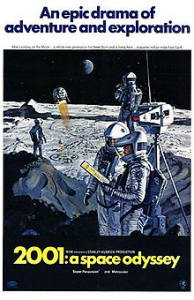 Theatrical release poster by Robert McCall. HAL 9000 who has full control over a spaceship heading for Jupiter.
Theatrical release poster by Robert McCall. HAL 9000 who has full control over a spaceship heading for Jupiter.
1975
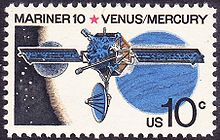 Mariner 10 Issue of 1975 ~space stamp.,
Mariner 10 Issue of 1975 ~space stamp.,
2008 Music. Tune Scotland the Brave for Praise to the Man. Performed by the Tabernacle Choir at Temple Square – [The Church of Jesus Christ of Latter-day Saints]
2012 Re release of Titanic 3D to commemorate the centenary of the sinking. James Cameron (clan Cameron) won Oscars for Best Director and Best Picture.
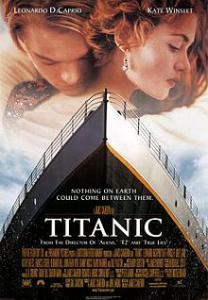 1997 theatrical poster. Cameron was born in Kapuskasing, Ontario, Canada, 1954, the son of Shirley (Lowe), an artist and nurse, and Phillip Cameron. His paternal great-great-great-grandfather emigrated from Balquhidder, Scotland in 1825; thus, he descends from Clan Cameron. Cameron is a member of the NASA Advisory Council and is working on the project to put cameras on an upcoming manned Mars mission. Cameron has also given speeches and raised money for the Mars Society, a non-profit organization lobbying for the colonization of Mars.
1997 theatrical poster. Cameron was born in Kapuskasing, Ontario, Canada, 1954, the son of Shirley (Lowe), an artist and nurse, and Phillip Cameron. His paternal great-great-great-grandfather emigrated from Balquhidder, Scotland in 1825; thus, he descends from Clan Cameron. Cameron is a member of the NASA Advisory Council and is working on the project to put cameras on an upcoming manned Mars mission. Cameron has also given speeches and raised money for the Mars Society, a non-profit organization lobbying for the colonization of Mars.
2013 The St. Andrews Society of the State of New York will be holding a black tie dinner to honor a high profile Scot. (Named for Duke of York, James Stewart, hence Albany place name.)
Disclaimer: The author of each article published on this web site owns his or her own words. The opinions, beliefs and viewpoints expressed by the various authors and forum participants on this site do not necessarily reflect the opinions, beliefs and viewpoints of Utah Standard News or official policies of the USN and may actually reflect positions that USN actively opposes.
Utah Standard News depends on the support of readers like you.
Good Journalism requires time, expertise, passion and money. We know you appreciate the coverage here. Please help us to continue as an alternative news website by becoming a subscriber or making a donation. To learn more about our subscription options or make a donation, click here.
To Advertise on UtahStandardNews.com, please contact us at: ed@utahstandardnews.com.


Comments - No Responses to “April 4th Scots Book of Days”
Sure is empty down here...